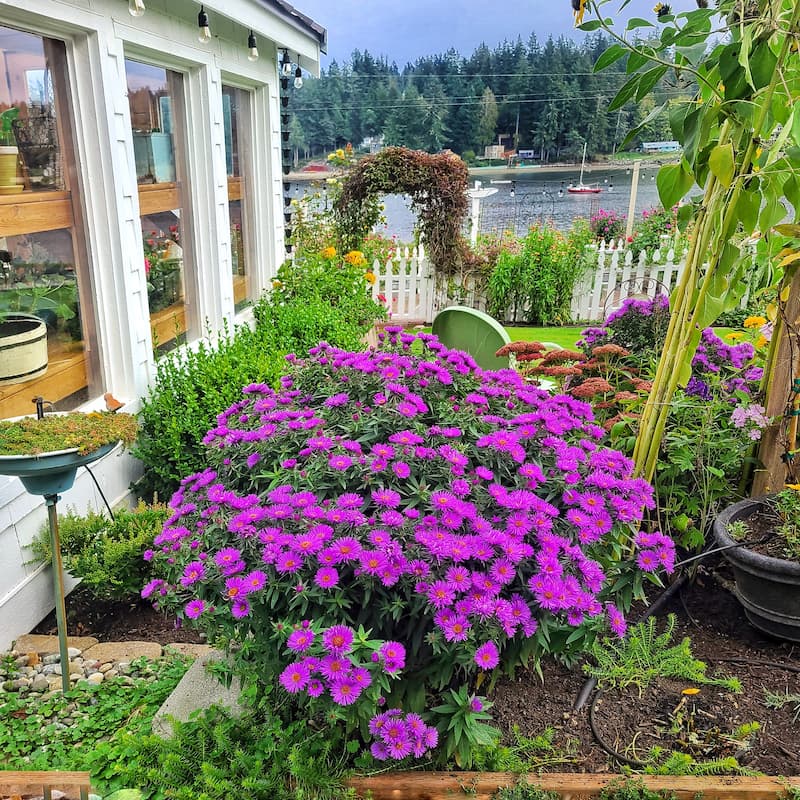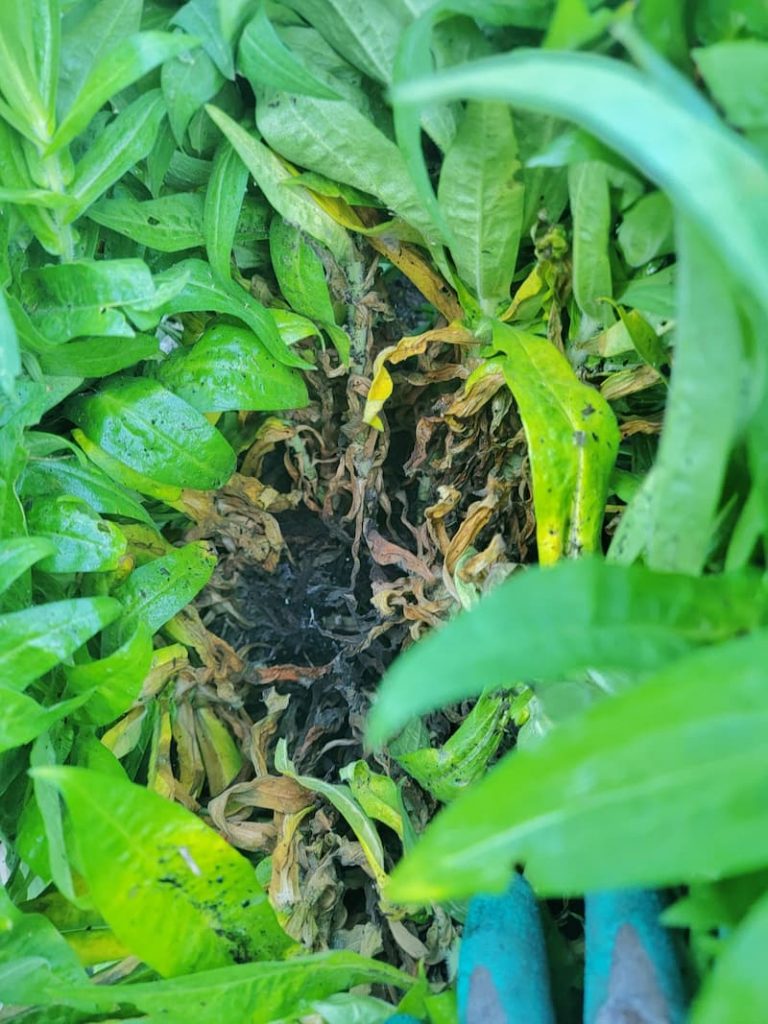28 Fall Gardening Tasks to Prepare a Flower Garden for Winter
Now that the leaves are falling from the trees and the flowers are fading away, what’s next for the garden? Here’s a fall task list to help you prepare your garden for the winter season.
When I was a new gardener, and summer was over, I was sad to see my flowers fade away with summer. But I looked forward to a much-needed break from the crazy hours I spent in the garden, tending to my flowers.
I had no idea that the hard work wasn’t over quite yet.

As an Amazon affiliate, I earn a commission from qualifying purchases at no additional cost to you. My blog also features other affiliate links for your convenience. Click here to read my privacy policy.

Preparing a garden for winter is one of the most important things you can do in the gardening year. With these fall tasks, you’re basically setting your garden up for success for the next season.
Here are 27 ways to prepare a garden for winter.
Cleaning and Clearing Out the Garden
1. Cut Back Infested and Diseased Plants
Now is the time to cut back perennials that are done blooming for the season and are diseased or pest-infested.
Diseased plants can spread to healthy ones if not removed. Cutting off a plant’s dead or dying foliage will help prevent fungal growth, infestations, and disease.
You can let many of the spent perennials decompose in the winter garden to add more nutrients back into the soil, as long as there are no signs of disease, pests, or fungus. If left through winter, they will also provide soil protection and reduce soil erosion.
Many seedheads are beneficial through the winter and can provide wildlife with food.
2. Remove Weeds in the Garden
Prepare the garden for winter by keeping weeds to a minimum through the fall and removing any invasive weeds in the garden beds.
3. Clear Debris and Fallen Leaves

Deadhead spent flowers cleaning up debris, such as faded blooms and fallen branches, and spent annual plants. This will help eliminate areas where insects and diseases overwinter.
Rake up and remove fallen leaves from the garden beds and lawn.
4. Divide and Transplant Perennials
Before the ground freezes, divide any mature perennials starting to overcrowd an area in your garden beds. Transplant these to other areas around your garden, or share them with friends and neighbors.
5. Clean and Store Garden Tools
It’s that time of year when seed trays, plastic markers, tomato cages, and gardening tools should be sterilized by soaking them in a water-bleach solution.
After soaking them, let them air dry before storing them in a garage, shed, or greenhouse for the winter.
Sterilizing your garden tools and equipment will help reduce mineral build-up. It will also help prevent the spread of fungus and bacteria to your new plants when you reuse the tools and pots.
Soil Care
6. Test Soil and Analyze

Check your soil in the garden to analyze it and understand its condition.
A soil test will give you an idea about what nutrients your plants might need for the next growing season. By knowing your soil’s pH level and nutrient content, you can make informed decisions about fertilizers and soil amendments.
Soil amendments such as compost, manure, straw, or well-rotted leaves will help enrich the soil, retain moisture, improve soil structure, and provide essential nutrients.
7. Add Organic Matter for Enrichment

Add organic matter, which is anything that contains carbon compounds formed by living organisms, to your soil. Examples are lawn clippings, leaves, stems, branches, moss, insects, earthworms, and microbes.
It also encourages beneficial organisms to thrive.
8. Mulch to Protect Roots

Spreading a 3-inch thick layer of mulch to your garden beds is an important fall task. Here are some of the benefits of adding mulch to your garden:
Did you know that you can use your fallen leaves for mulch? They make a great substitute for mulch and have many of the same benefits.
9. Cover Crop for Nutrient Retention
When getting your garden ready for winter, consider cover cropping. Instead of leaving your soil bare during the cold season, plant crops like clover or rye, which act as protective covers.
These cover crops keep your soil in place, preventing erosion, and their roots help retain essential nutrients. Once spring comes, you can turn them into the soil, enriching it with all those stored nutrients.
Protect Plants
10. Dig up Tender Bulbs and Tubers to Prepare for Winter

Dahlia tubers and other tender bulbs will not survive the winter months in hardiness zones seven and below. In those parts of the country, they need to be dug up shortly after the foliage turns brown in fall for winter protection.
At the end of the season, store them in a cool, dry place through the winter.
I’m in hardiness zone 8b and have a much milder winter climate. I leave my tubers and bulbs in the ground throughout the winter but add a few inches of mulch around the plants to protect them from damage caused by freezing temperatures and heavy snow.
11. Overwinter Tender Plants

Tender plants are sensitive to cold temperatures and are more likely to be damaged or killed by frost or freezing conditions. Examples of tender plants include:
One of the items on my fall task list to prepare my garden for winter is to overwinter my geraniums in the greenhouse. If you don’t have a greenhouse, no need to worry. There are still other ways to overwinter your geraniums.
Winterize Your Garden
12. Store Items from the Garden

Bring garden furniture, accessories, structures, and equipment indoors before the freezing temperatures.
13. Insulate Cold Frames and Greenhouses
Adding insulation, such as bubble wrap, row covers, or blankets, can trap heat and prevent frost from entering. This extra layer of protection can make all the difference in maintaining a thriving garden throughout the cold season.
Pest and Disease Control

We all have annoying pests in our gardens, but we don’t want to use harsh chemicals on our plants. Here are some natural and organic methods that will help control pests in the garden this winter.
14. Remove Potential Pest Habitats
Fallen leaves, garden debris, and old plant material can all become cozy hideaways for pests during the winter. By clearing away these hiding spots, you can reduce the likelihood of infestations in the spring.
15. Apply Dormant Oils or Natural Pest Repellents
Dormant oils can be sprayed on trees and shrubs during their dormant season, smothering overwintering insects and their eggs.
Use natural repellents like neem oil or garlic spray.
These eco-friendly solutions help prevent pest infestations and keep your garden safe and healthy throughout the winter months.
16. Inspect Plants for Signs of Disease
Look for discolored leaves, spots, or unusual growth patterns.
Catching and addressing any issues now can prevent diseases from spreading and becoming more problematic in the spring. If you spot problems, prune affected parts or use disease-resistant varieties when replanting.
Harvest and Compost
17. Harvest Flowers

Harvesting your garden before winter sets in helps ensure it won’t be lost to frost or pests, and you can enjoy it indoors.
18. Compost Garden Waste
Collecting fallen leaves and garden waste in a compost pile or bin creates a valuable resource for your garden.
As these materials break down over time, they transform into nutrient-rich compost that can be used to improve soil quality in the spring. Composting reduces waste and enriches your garden’s soil, making it more fertile and productive.
Green materials include anything still alive or wet, such as green leaves, grass clippings, and manure. They contain more nutrients, including nitrogen, and compost more quickly.
Watering and Irrigation

Effective water management in the garden becomes essential as winter approaches to protect plants and prevent damage. Preparing for freezing temperatures, monitoring moisture levels, and mulching around plants will help keep your plants safe during the winter season.
19. Adjust Watering Frequency
As you prepare your garden for the winter months, one essential adjustment is your watering routine.
With cooler temperatures and shorter daylight hours, plants generally require less water. Overwatering can lead to root rot and other problems, so cutting back on watering frequency is a good idea.
Monitor the weather, soil moisture, and the specific needs of your plants, and adjust accordingly.
20. Mulch Around Plants
Add a layer of organic material, such as straw, wood chips, or leaves, to help insulate the soil and prevent it from freezing too quickly.
This insulation keeps the soil warmer and helps retain moisture that plants need to survive the colder weather. Mulch acts as a protective blanket, reducing the chances of roots freezing and minimizing plant stress.
It also prevents soil erosion from winter rains and melting snow, safeguarding your plants until spring arrives.
21. Drain and Store Garden Hoses
When water freezes inside hoses, they can crack and become useless. So, before the winter chill sets in, disconnect your hoses, drain them completely, and coil them neatly for storage.
22. Protect Outdoor Water Features from Freezing
As temperatures drop, the water in fountains, ponds, and birdbaths can freeze, potentially causing damage. To prevent this, consider investing in a floating de-icer or a submersible heater to keep the water from freezing completely.
Winter Planting
23. Plant Spring Bulbs

As the gardening season winds down and winter approaches, it’s a great time to plan for a vibrant spring.
One way to do this is by planting spring bulbs before the first hard freeze. Flowers like tulips, daffodils, and crocuses are planted in the fall, and they’ll stay cozy underground until the following spring.
24. Plant Trees and Shrubs
Fall is an ideal time to plant trees and shrubs. The soil is still warm enough for the roots to establish if you plant well before the first frost of the season, giving the plants time to acclimate before the cold weather.
25. Sow Cover Crops to Protect Soil
Cover crops like clover, rye, or winter wheat can be planted in the fall to shield your garden beds from the harsh winter elements.
When turned under in the spring, they help prevent soil erosion, suppress weeds, and enhance soil health by adding organic matter.
Garden Journaling

Keeping a detailed record of your gardening activities in a garden journal or planner makes it easy to note successes and failures and plan for future garden adjustments.
26. Document Your Garden’s Current State
Before winter arrives, take a moment to document your garden’s current state, whether it’s by taking pictures or writing down some notes.
This step can help you plan for improvements, track plant growth, and identify any problems that need addressing when spring comes around.
27. Note Any Issues or Successes from the Gardening Season
As you gear up for winter, this is a great time of year to reflect on your garden’s journey.
Make a note of any issues or successes you’ve experienced. Did you discover a pest problem that needs addressing next year? Or maybe you grew a new variety of flowers that you loved.
28. Create a Winter Maintenance Schedule
Establish a winter maintenance schedule for your garden. It might include checking for damage after heavy snowfall and inspecting overwintering plants.
Planning ahead and having a clear schedule allows you to manage winter garden care without feeling overwhelmed.
Most Common Questions for Preparing the Garden for Winter
Should I Cut Down My Flowers Before Winter?

It can be tempting to tidy up your garden by removing spent flower heads, but it is often a good idea to leave them standing through the winter.
These plant stalks can provide essential habitat and food for overwintering insects and birds. They can also act as a protective layer, shielding the crown of perennial plants from harsh winter weather.
Garden Supplies and Tools
Check out my favorite garden supplies and tools for the growing season. Whether you’re looking for potting soil or deer repellent, you’ll find what I use in my own garden.
How Do I Protect My Flower Garden in the Winter?
Adding a layer of winter mulch is one simple way to protect your flowering plants.
Apply a thick layer of organic mulch, such as straw, leaves, or leaf mold, around your flower beds to insulate the soil and regulate temperature. This helps prevent freeze-thaw cycles that can damage plant roots.
You can add frost blankets or burlap wraps to individual plants for extra protection.
Should I Cover My Flower Garden in the Winter?

Covering your flower garden during the winter can be a wise move, especially if you live in an area with harsh cold and frost.
Covering your plants with materials like burlap or frost blankets can shield them from freezing temperatures and frost damage. This protection is particularly crucial for delicate or newly planted flowers. However, not all plants require covering, and some hardy varieties can withstand winter without extra insulation.
What Perennials Should Not Be Cut Back in the Fall?

Knowing which perennials should not be cut back is essential for fall garden chores. Some hardy plants benefit from leaving their foliage intact during the winter.
Plants like ornamental grasses, sedums, and coneflowers, with their seed heads and unique textures, provide visual interest in the garden and offer shelter and food for birds and beneficial insects during the colder months.
When Should I Winterize My Flower Beds?
It’s a good idea to start the process in late fall, typically after the first hard frost or when the weather begins to cool significantly.
Winterizing involves tasks like mulching, cutting back certain plants, and protecting delicate plants. Getting a head start in late fall ensures your flower beds are adequately prepared for the colder months ahead.
How Do You Prepare Perennials for Winter?

As the gardening season winds down, focus on a few key steps to ensure their survival.
First, trim back any dead or diseased foliage and remove fallen leaves to prevent disease and pests from overwintering. Next, add a layer of mulch around the base of your perennials to insulate the soil and protect their roots from freezing temperatures.
Consider providing additional support and stake taller varieties to prevent them from flopping under the weight of snow or ice.
If you live in an area with extremely harsh winters, you might want to cover your perennials with burlap or frost blankets for added protection.
Final Thoughts

I hope these fall gardening tasks help you create your own plan to prepare your garden for winter. By completing these projects now, your garden will be even healthier and successful next spring.
If you have any questions or additional suggestions, please share them in the comments below. And be sure to share this blog post link with anyone who may find these gardening tips useful.
Until next time,
Happy Gardening!

I’m a self-taught hobby gardener. Everything I share on my blog is my opinion and what worked for me.
MORE POSTS
For You to Enjoy
Follow Me for More Inspiration
Shop my Amazon Storefront, LTK sources, and my favorite home decor, garden, and lifestyle products. When you purchase from one of my links, I earn a small commission, which helps me continue sharing all the content you expect on my blog.
Be sure to follow me on Pinterest, Instagram, Facebook, TikTok and LIKEtoKNOW.it. Do you like gardening? Join my Facebook Gardening Tips & Tricks group.
If you haven’t already, subscribe to my blog at the bottom of this post so you’ll never miss a thing.











Great tips! Your garden’s always look gorgeous. I need to get busy in my gardens. Hugs to you.
Great tips Kim! Your garden looks so pretty!
I haven’t done anything yet!! I planted a few bulbs last week and have to finish them this week. I keep avoiding looking at all the work I have to do out there. I think I’m going to wait until Spring to move my perennials because I need to work on the layout a little.
Kim, I am awaiting a large order of tulips from Longfield Garden and I need to get those in the ground soon. Our gardening session is heating up so lots of work this time of year. We don’t have the freezing temperatures but it is a good time to plant trees and shrubs. Thanks for all the great tips!
Kim, these are all really great tips. I plan on spending time this week out there doing some trimming back of plants and some extra mulch around some new plants.
Kim,
Such a great post and perfect timing. I’m sharing a link on Sunday. Thanks for sharing your talents.
Thank you for the great tips! They are so helpful to me. I am not looking forward to digging out all of my dahlias, that will be so much work this year.
Hi Kim, great information and I sure hope I get it all done!
Thank you Pam, It can be a bit overwhelming for sure. Especially if the weather is bad. Good luck my friend!
Thank you so much Stacy! Yours looks fabulous as well.
Hi Diana, I can see how this could be confusing. What I meant by debris was fallen branches, spent flower buds and plants that have died off for the season. I hope that clears it up.